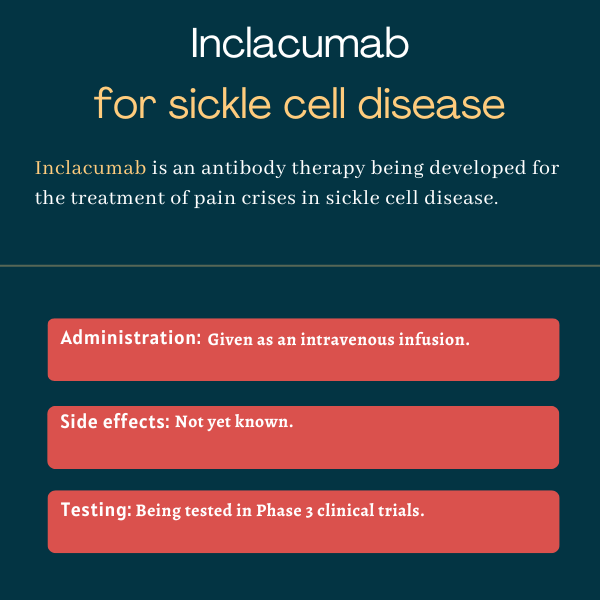
Inclacumab for sickle cell disease
Last updated May 21, 2024, by Lindsey Shapiro, PhD

What is inclacumab for sickle cell disease?
Inclacumab, also known as PF-07940370, is an antibody-based therapy being developed to prevent painful vaso-occlusive crises (VOCs) in people with sickle cell disease (SCD).
The experimental treatment is now under development by Pfizer, which plans to seek a marketing approval for its use in SCD by 2026. Pfizer acquired the intravenous, or into-the-vein, therapy from Global Blood Therapeutics in a 2022 deal. It was originally developed by Roche, where it was being evaluated as a potential treatment for certain cardiovascular conditions.
Inclacumab was granted orphan drug and rare pediatric designations by the U.S. Food and Drug Administration (FDA) in 2022. These regulatory statuses are intended to help speed a therapy’s clinical development and regulatory review.
Therapy snapshot
| Treatment name: | Inclacumab |
| Administration: | Being tested in sickle cell disease as an intravenous infusion |
| Clinical testing: | In Phase 3 clinical testing |
How does inclacumab work in sickle cell disease?
In SCD, mutations in the HBB gene lead to the production of a faulty version of hemoglobin, the protein that helps red blood cells carry oxygen. In turn, red blood cells take on an abnormal, sickle-like shape and become prone to clumping up and blocking blood vessels, hampering blood flow and leading to pain crises known as VOCs. Fully called vaso-occlusive crises, they occur when oxygen delivery to body tissues is compromised.
The process is mediated by abnormal interactions between sickled red blood cells, the endothelial cells that line blood vessel walls, platelets — cell fragments involved in blood clotting — and leukocytes, or immune cells.
Inclacumab is an antibody that selectively targets P-selectin, a cell adhesion molecule produced by endothelial cells and platelets that mediates these interactions. P-selectin normally plays an important role in the intercellular interactions needed to promote inflammation and blood clotting in response to injury, but it also enables sickled red blood cells to stick to those other cell types and cause VOCs.
For its part, inclacumab essentially interferes with these interactions, preventing the blockages that lead to pain crises in SCD patients. Its mechanism of action is similar to that of Adakveo (crizanlizumab), an approved SCD therapy, but inclacumab binds to a different region on the P-selectin protein and is intended to allow for less frequent dosing.
How will inclacumab be administered in sickle cell disease?
In clinical trials involving SCD patients, inclacumab is being administered via intravenous infusion at a dose of 30 mg/kg of body weight once every 12 weeks, or about three months.
Inclacumab in sickle cell disease clinical trials
After being found safe in Phase 1 trials, two Pfizer-sponsored Phase 3 trials — THRIVE-131 (NCT04935879) and THRIVE-132 (NCT04927247) — were launched in 2021 to investigate inclacumab’s safety and effectiveness in SCD.
THRIVE Phase 3 trials
THRIVE-131 enrolled 240 SCD patients, ages 12 and older, who had experienced 2-10 VOCs within the year prior to screening. Participants were randomly assigned to receive intravenous inclacumab (30 mg/kg) or a placebo once every 12 weeks, for 48 weeks, or nearly a year. The study’s main goal is to evaluate the rate of VOCs over that period.
THRIVE-132 similarly planned to enroll 280 SCD patients, ages 12 and older, who had been experiencing VOCs. Enrolled patients were to be randomly assigned to receive a single dose of inclacumab or a placebo, and be monitored for three months to evaluate the rate of hospital readmissions due to VOCs. However, this study was terminated in November 2023 with an enrollment of 72 participants, with Pfizer citing poor patient accrual and recruitment challenges.
Participants who completed treatment in either THRIVE study can enter into the THRIVE-133 (NCT05348915) open-label extension study, in which all will continue to receive inclacumab infusions every three months for as long as five years. The goal for this study is to monitor inclacumab’s long-term safety and efficacy.
Some studies are still underway and no data has yet been announced.

Common side effects of inclacumab
Clinical trials of inclacumab in SCD patients are still ongoing, and as such, its side effect profile in this population is not yet known.
Sickle Cell Disease News is strictly a news and information website about the disease. It does not provide medical advice, diagnosis, or treatment. This content is not intended to be a substitute for professional medical advice, diagnosis, or treatment. Always seek the advice of your physician or other qualified health provider with any questions you may have regarding a medical condition. Never disregard professional medical advice or delay in seeking it because of something you have read on this website.
Recent Posts
- Standard sickle cell treatments slash stroke risk in children: Review
- Is sickle cell disease considered a disability?
- Tips for enjoying the most wonderful time of the year with sickle cell
- Big Nova donates $3M to expand access to stem cell transplants
- Investigational SCD therapy shows stronger results at higher dose
- Risto-cel showing lasting benefits for people with severe SCD in trial
- The price of living with a physical disability in a non-inclusive society
- Casgevy safely prevents sickle cell crises in children: Trial data
- Curcumin skin gel shown to improve heart health in SCD mice
- Socioeconomic status not linked to stroke risk in children with SCD
Related articles




